OneManGang
Senior Member
- Joined
- Sep 7, 2004
- Messages
- 2,026
- Likes
- 9,620
Tennessee vs The Maxims vs Kentucky
DATE: 28 October 2023
PLACE: Commonwealth Stadium, Lexington, KY
ATTENDANCE: 61,665
FINAL SCORE: Tennessee 33 Kentucky 27
In ancient Greek mythology, one finds the story of Sisyfus.
Sisyfus was king of Ephyra who cheated Death twice and committed the crime of hubris by coming to regard himself as cleverer than Zeus. Sisyfus did at last die and entered into the realm of Hades. Hades punished him for his hubris and condemned him for eternity to roll a boulder up a mountain only for the boulder to roll back down the slope as soon as he neared the summit and then he would have to do it all over again. In modern times, the cartoonist Charles Schulz resurrected this tale by having Lucy constantly jerk the ball away as just Charlie Brown ran up to kick it.
I can think of no more appropriate metaphor for Kentucky football.
Season after season, the MildKats start off strong, beat a Florida or Mizzou and maybe show up in the rankings. Then reality sets in. An SEC season is a war of attrition and if your team isn't 2-3 deep at every position, disappointment is in your future.
Like Vandy, Kentucky is, at best, one deep.
MildKat football also labors under another burden. Ever since Adolph Rupp strolled onto campus, football has been something to do until the start of basketball season.
We've discussed here before the proliferation of “That's Nice” sports on college campi.* Bluntly, these are sports such as volleyball, lacrosse, or track and field. Should one of these achieve an SEC title or should one of the athletes involved earn All-America honors, we sports fans look at the write-up in the paper and think, “Well, that's nice.”
In the Bluegrass (and trust me, I've been there for this phenomenon) once basketballs hit hardwood UK football becomes a “That's Nice” sport. This also explains why the MildKats play in the second-smallest stadium in the SEC. Only Vanderbilt's Crudley Field is smaller.
In many ways, KatHead Stoops's most important season objective is to not do anything to get the basketball program in trouble. Thus far, during his sojourn in Lexington he has been successful. Given that track record, eventually he will be the Dean of SEC coaches.
OK, let's get to the football action.
During the week leading up to the game, we Vol fans were treated to everyone telling us that Kat running back Ray Davis was going to light up Tennessee. As the SEC's leading rusher, KatPeople were confident.
The KatPeople got the opening kick and promptly handed the ball to the estimable Mr. Davis, who got stuffed at the line. Stunned, the Kats tried a screen and lost five yards. Davis came up short on 3rd down.
The Kats punted.
The Vols ran and passed to a 2nd and 3 on the Kat 44, whereupon Joe handed the ball to Jaylen Wright who was next seen 56 yards away in the UK end zone.
Davis was stymied on the next KY possession, failing on 4th and 1 at the Bluebelly 34.
The Vols didn't do much better but got down to the 26 from which the Automatic Toe, Charles Campbell, nailed the field goal.
The Kats rode Dennis Leary's arm pretty much from here on out. The Vols sold out to stop Davis and Leary had a career day. The Incredible Disappearing Vol Pass Defense (IDVPD) aided him greatly. To start with, the secondary couldn't cover receivers with a coat of paint and the Vols' vaunted pass rush got exactly one sack for the whole game.
Be that as it may, the KatPeople had the ball, 3rd and 9 at the Vol 10 as the quarter ended. KatPeople salivated.
End of 1st Quarter
Score: Tennessee 10 Kentucky 0
However the Vol defense bowed and the Kats settled for a field goal.
Tennessee added a field goal.
Leary then picked apart the IDVPD with a 7-play, 75-yard touchdown drive.
Bazooka Joe responded with a 39-yard TD strike to Chas Nimrod.
Leary picked up where he left off and Davis scored on a 7-yard run.
Joe Milton led an outstanding 2-minute drill to end the half. He was perfect throwing the ball and Campbell got a field goal from the Kat 26 with 5 seconds left.
There was a controversial catch by Keyton on the sideline that had the Kats grumbling. Review confirmed it. Maybe it was, maybe it wasn't. After all the crap the Vols have endured from SEC refs in the last three games, frankly, I don't care.
End of 2nd Quarter
Score: Tennessee 23 Kentucky 17
Tennessee took the opening kick and did essentially nothing.
The Kats drove to the UT 34 where they failed on 4th down.
The Vols drove to the UK 17 where a sack of Milton on 3rd down resulted in yet another Campbell field goal.
Leary then picked apart UT's IDVPD for another 75-yard touchdown drive.
End of 3rd Quarter
Score: Tennessee 26 Kentucky 24
The Vols had the ball as the 3rd quarter ended but had to punt.
Kentucky then ended up on the Tennessee 35, but their 53-yard field goal try went astray.
The ensuing Vol possession featured a simple formula. To paraphrase John Ward describing an earlier Vol triumph, “Give the ball to #6 (points) go that way.” And go he did. It was the Dylan Sampson show. The explosive running back capped his drive with a 12-yard TD run. Running and catching the ball, he provided 59 of the 65 yards needed. Well done, young man!
Kentucky added a field goal.
A couple of first downs by Tennessee and that was that.
The end of the game, though, was classic KatPeople idiocy and showed they really don't take football seriously. With 44 seconds left a MildKat lineman fell to the turf to kill the clock. Unfortunately for them, such an action triggers an automatic 10-second runoff. With 34 seconds left on the game clock and 40 on the play clock the Vols simply walked off the field victorious and the KatPeople started talking basketball.
Heh.
Final Score
Tennessee 33 Kentucky 27
*******
A God’s-eye view of the United States in July of 1945 would have revealed a nation truly mobilized for war. On both coasts, shipyards were disgorging vast numbers of sleek warships, fat transports and waddling tankers. Further inland, vast industrial complexes were churning out masses of trucks, jeeps, squat tanks and shiny warplanes. Hundreds of thousands of acres were host to military bases and airfields where millions of young men were being instructed in the deadly arts.
It would have been very easy in this Olympian vision to overlook things with great significance. It would be understandable to pass over factories and facilities located in out-of-the-way places. While apparently quite busy, with thousands of workers and complicated infrastructure these plants seemed to produce … nothing.
It was called the Manhattan Project.
It started with a letter. Three prominent physicists had fled Hungary as war clouds gathered in the late 1930s. They had contacts with colleagues in Nazi Germany and had found that those scientists were busily trying to harness the power of nuclear fission and that research could lead to weapons of unimaginable destructiveness. Upon reaching the United States, Leo Szilard, Eugene Wigner and Edward Teller found that nuclear research, in this country, was very much a cottage industry with only a few physicists devoting themselves to the subject. To beat Hitler at his own game would require much more.
In the summer of 1939 the three men prevailed on their most famous colleague, Albert Einstein, to help them compose and then add his signature to a letter to President Franklin Roosevelt outlining this threat and advocating increased research and development with an eye to creating (if possible) a weapon for the Allies. Unknown to the Hungarians, the Japanese were also doing some research into atomic weaponry as well.
Roosevelt endorsed Einstein’s letter and turned the problem over to the Office of Scientific Research and Development (OSRD), a committee of leading individuals in science, industry and government set up to sort through various proposals, decide which were feasible, then oversee the resulting projects. OSRD recommended grants totaling $300,000.00 to begin the process.
By May, 1942, this initial research revealed there were three potential methods of producing adequate enriched Uranium for research and possibly for a weapon. The OSRD compiled a report of their progress to date and submitted it to the President with their recommendation that since no single method seemed the best, the quickest method of producing a usable weapon would be to pursue all five with massive funding and an absolute priority on resources. Roosevelt read the report, took a deep breath and scrawled OK, FDR on the top page. America was going nuclear.
Overall responsibility for the project, now codenamed MANHATTAN, was given to the U.S. Army under the auspices of Secretary of War Henry Stimson and the Army Chief of Staff, General George C. Marshall. Marshall needed a man used to big projects and with a reputation for getting things done to lead the Manhattan Project and he knew just the man. The War Department was moving into the largest enclosed office building in the world in 1942, the Pentagon. In had been completed on time and under budget by a Colonel from the Corps of Engineers named Leslie R. Groves.
Groves was a human bulldozer capable of doing vast amounts of work and had a congenital aversion to delay. Groves knew little of theoretic physics or atomic theory, but he could tell when things were getting done and when the scientists were just arguing minor points among themselves for personal amusement. That latter was strictly verboten.
Groves tapped Dr. Robert Oppenheimer to handle the scientific side of the project while he, Groves, deal twith brick and mortar issues of supply, logistics and construction. The personal contrast between the determined, no-nonsense, bull-necked Groves and the rail-thin, brilliant and diffident Oppenheimer could not have been greater. The important thing was: it worked.
Efforts soon resolved into two paths: weapons development and the production of the fissile materials to use in them. The fissile materials were enriched uranium (U235) and plutonium (Pu239). Both had been produced in laboratories, but nobody really had any idea how to scale that up to produce enough to use in a weapon. Literally, the amount of either produced to date was measured in individual atoms.
Three locations were chosen for the work. Plutonium production would take place in a sprawling complex on the banks of the Columbia River near Hanford, WA. Weapons design, production and testing would be done near Los Alamos, NM. Finally, U235 production would be done on a vast site west of Clinton, TN, code-named the Clinton Engineer Works.
The Clinton Engineer Works would encompass three primary facilities. Y-12 would use an electromagnetic separation method. K-25 would use a system of pumps and barriers to separate U235 from a substance called uranium hexafloride gas – one of the most corrosive elements known. Finally they would construct the world's second nuclear reactor at site X-10 to explore using reactors to produce plutonium. That method would then be employed at Hanford.
X-10 and Y-12 are beyond the scope of this essay, so we will concentrate on K-25.
The only metal that could resist the corrosive gas was pure nickel. Making the literally thousands of feet of pipe, not to mention the diffusers and the pumps out of solid nickel would use up the world's production for about a decade. No method of electroplating could do the job so one had to be invented. Then there was the issue of the barriers which also had to be nickel plated and small enough to allow the passage of individual atoms, those also had to be invented. Finally, the entire process had to be capable of running for extended periods with essentially no maintenance.
Meanwhile, despite the fact that they weren't really sure what the final process design would look like, construction of the massive K-25 building began. In total the K-25 complex would cover over 120,000 acres.
The building itself was a concrete structure in a “U” shape with the legs 2,450 feet long and five stories high. At its completion, it was the largest enclosed structure on the planet.
Volumes have been written on just how this was done and we simply don't have room here to cover all that.
In terms of cost, the K-25 building BY ITSELF cost more than the entire Hanford complex.
But it got done. K-25 started production even as construction was taking place. The enriched uranium produced there was fed to the cyclotrons at Y-12 and by the early summer of 1945 roughly 120 lbs. of U235 had been produced. It was not enough for a test device. It was enough for one bomb. The first “test” of the uranium device would be its use in combat.
On 6 August 1945 at 0755, a radar altimeter in the device fired the detonator over Hiroshima, Japan, and most of the city was laid waste. Just like the eggheads said it would.
One last story has to be told. Secrecy throughout the project was absolute. Counter-intelligence agents worked throughout the place. On of them button-holed a construction worker at K-25 and asked him what he thought that plant was for. Such speculation was strictly forbidden and could result in prison time.
The worker leaned on his shovel and said, “Yeah, I know just what this here building is for.” The agent knew he had a “live one” and asked, “Oh, really?” The worker spit and said, “Yep, this here plant is for the production of the front ends of horses. To be sent to Washington for final assembly.”
The agent collapsed in laughter and went away.
********
So, how did the Vols do against The Maxims?
1. The team that makes the fewest mistakes will win.
Kentucky made the fatal mistake of being Kentucky. They bask in the reflected glory of their basketball program and don't have to do much to satisfy the fan base. Also, in the recruiting wars they are trapped between Tennessee, Ohio State, Penn State and Notre Dame. Sucks to be them it does.
2. Playfor and make the breaks. When one comes your way … SCORE!
Last week I took the Vols to task for going for it on 4th down deep in their own territory. Then Stoops does it from the Kat 34 and fails. The Vols got three of their six-point victory margin off that.
3. If at first the game – or the breaks – go against you, don't let up… PUT ON MORE STEAM!
Bazooka Joe may have had his best game ever as a Vol. He made good decisions, ran the ball with authority and did a lot of the little things an NFL-level quarterback needs to do that don't make the highlight reels.
4. Protect our kickers, our quarterback, our lead and our ballgame.
Milton got sacked twice but otherwise seemed to have fairly clean pockets to work from most of the time.
5. Ball!Oskie! Cover, block, cut and slice, pursue and gang tackle … THIS IS THE WINNING EDGE.
ZERO turnovers created. Cover?!?!? There were points when Vol fans were happy to simply see a UT defender in the same screen shot as a UK receiver. Part of the DBs' problems though were caused by the Kat's scheme to deal with the Vols' fearsome pass rush. Arguably two of the best defensive linemen in the league are Tyler Baron and James Pearce. Between the two of them Saturday they had 4 – count 'em - FOUR – tackle assists, no hurries and no sacks. Don't think that Georgia and Mizzou aren't going to mine that game film. I noticed from the beginning that Pearce goes deep on his rush, ostensibly to make sure the quarter back doesn't scramble to his side, Problem: the Kat offensive tackle simply pushed Pearce further past Leary and then the guard took the defensive tackle with him leaving a five- to ten-yard opening in the middle. Leary could have run for miles except he didn't have to. He had more than enough time. He didn't have to look for an open receiver, his biggest decision was which of the ones running free to choose. That said, shutting down Davis was the difference in the game. The Vols' run blocking was simply outstanding.
6. Press the kicking game. Here is where the breaks are made.
Charles Campbell was the margin of victory. He must have heard me griping last week about field goals being “booby prizes.” I'll take my crow fried, please.
7. Carry the fight to Kentucky and keep it there for sixty minutes,
Works every time.
Homecoming is up next with UConn. Win this one for Coach Pat, boys.
*Classical reference
Suggested Reading:
Stephane Groueff, Manhattan Project: The Untold Story of the Making of the Atomic Bomb. Bantam Books, 1968.
Charles W. Johnson and Charles O Jackson, City Behind A Fence: Oak Ridge, Tennessee, 1942-1946. University of Tennessee Press, 1981.
Richard Rhodes, The Making of the Atomic Bomb. Simon & Schuster, 1986.
K-25. (NARA)

One of the diffuser assemblies inside K-25 (NARA)

Last edited:


